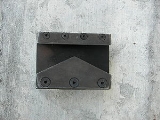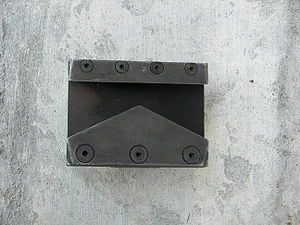
K-tool
Encyclopedia

Fire department
A fire department or fire brigade is a public or private organization that provides fire protection for a certain jurisdiction, which typically is a municipality, county, or fire protection district...
s for forcible entry
Forcible entry
Forcible entry is defined by Merriam-Webster's Dictionary of Law as the unlawful taking of possession of real property by force or threats of force or unlawful entry into or onto another's property, especially when accompanied by force....
. It is used in conjunction with a Halligan bar
Halligan bar
A Halligan bar is a special forcible entry tool commonly used by firefighters and law enforcement. It was designed by and named after Hugh Halligan, a First Deputy Fire Chief in the New York City Fire Department, in 1948...
and a flat-headed axe
Axe
The axe, or ax, is an implement that has been used for millennia to shape, split and cut wood; to harvest timber; as a weapon; and as a ceremonial or heraldic symbol...
or maul
Maul
A splitting maul also known as a block buster, or block splitter is a heavy, long-handled hammer used for splitting a piece of wood along its grain. One side of its head is like a sledgehammer, and the other side is like an axe.- Wedged mauls :...
(commonly referred to as "irons" or (with a maul instead of an axe) "strong irons") to remove a cylinder lock
Cylinder lock
A cylinder lock is a lock constructed with a cylinder that a locksmith can easily unscrew to facilitate rekeying. The cylinder may contain any of a variety of locking mechanisms, including the pin tumbler lock, the wafer tumbler lock and the disc tumbler lock....
. It consists of a steel block roughly 3 inches by 3 inches by 1 inch thick with a K-shaped notch on one side, having sharp edges that grip the cylinder, and a U-shaped flange on the other side. The notch is slipped over the lock cylinder, then forced down by striking with the flat side of the axe or maul. The halligan is then inserted into the flange and used to pry the K-tool off the door, thereby pulling the entire key cylinder out. The bolt is then retracted from the inside of the cylinder hole using a turning tool, such as a screwdriver.
Some cylinder locks include additional shields (outside and internally) that will make this type of entry more difficult and time-consuming, and there may be additional (non-cylinder) locks to deal with.
The K-tool can be used on most styles of door, although it is often faster to use the irons (combination of an axe and halligan tool) or a hydraulic ram on a solid door. The benefit of a K-tool comes where it is impractical or dangerous to break the door, for example, the large plate-glass doors in front of a commercial building will quickly yield to a well-placed blow from an axe, but may send fragments of glass flying, and will result in a pile of broken glass. The K-tool can be used to pull the core from the lock without damaging the door itself. The K-tool is also useful during investigations where no fire is readily evident. The core can be pulled from a lock, which can often be repaired at lower cost than replacing a door and jamb damaged by other, more energetic entry methods.

